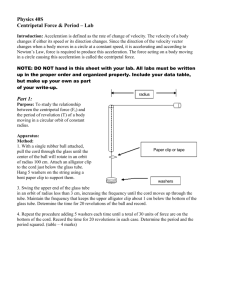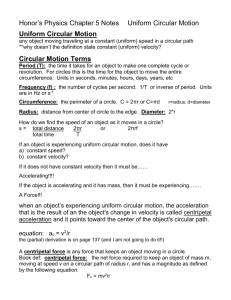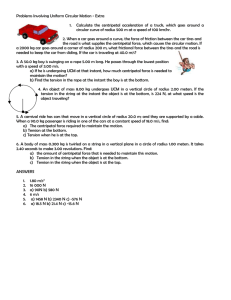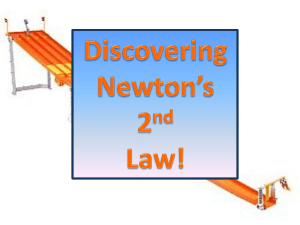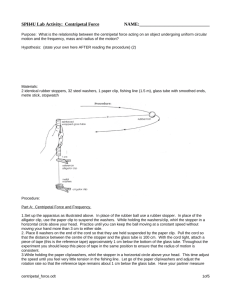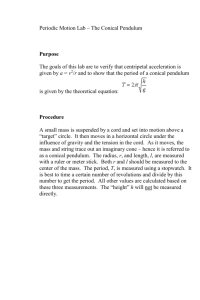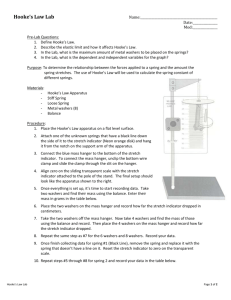Lesson Plan
advertisement
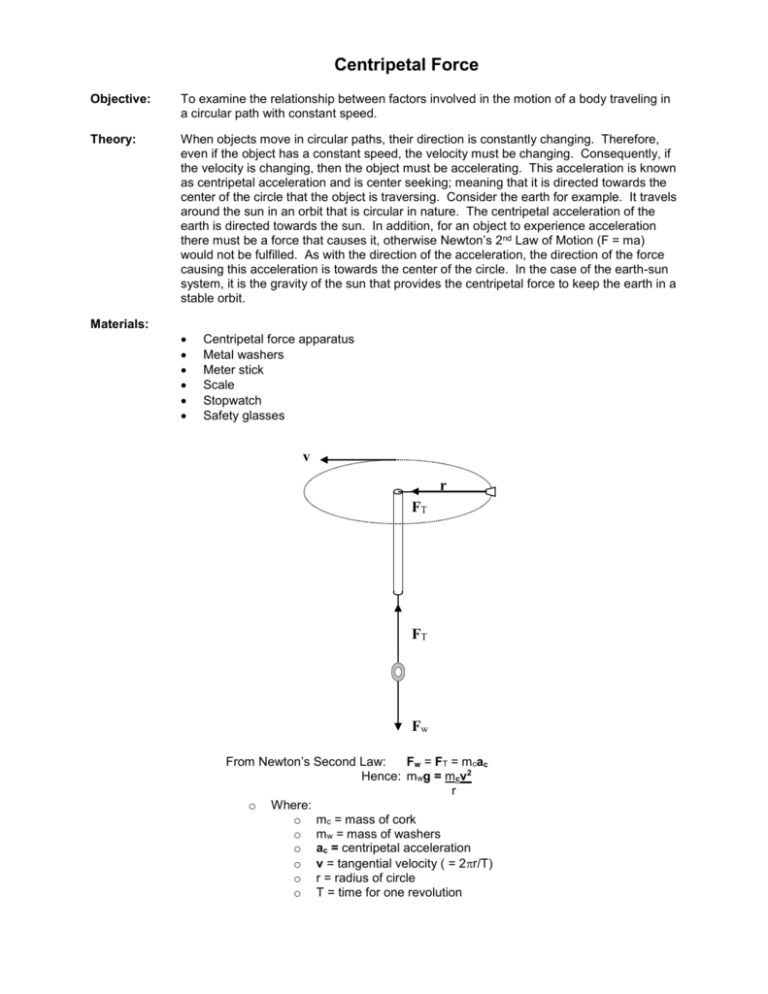
Centripetal Force Objective: To examine the relationship between factors involved in the motion of a body traveling in a circular path with constant speed. Theory: When objects move in circular paths, their direction is constantly changing. Therefore, even if the object has a constant speed, the velocity must be changing. Consequently, if the velocity is changing, then the object must be accelerating. This acceleration is known as centripetal acceleration and is center seeking; meaning that it is directed towards the center of the circle that the object is traversing. Consider the earth for example. It travels around the sun in an orbit that is circular in nature. The centripetal acceleration of the earth is directed towards the sun. In addition, for an object to experience acceleration there must be a force that causes it, otherwise Newton’s 2nd Law of Motion (F = ma) would not be fulfilled. As with the direction of the acceleration, the direction of the force causing this acceleration is towards the center of the circle. In the case of the earth-sun system, it is the gravity of the sun that provides the centripetal force to keep the earth in a stable orbit. Materials: Centripetal force apparatus Metal washers Meter stick Scale Stopwatch Safety glasses v r FT FT Fw From Newton’s Second Law: Fw = FT = mcac Hence: mwg = mcv2 r o Where: o mc = mass of cork o mw = mass of washers o ac = centripetal acceleration o v = tangential velocity ( = 2r/T) o r = radius of circle o T = time for one revolution Pre-Lab: mv 2 Refer to the formula for centripetal motion to answer the following questions. F c r For graphs 1 and 2 below, assume that the mass of the cork and the radius of the circular path are kept constant. 1. Sketch the graph for force vs. speed. 2. Sketch the graph for the force vs. speed2. (1) (2) For graphs 3 and 4 below, assume that the force due to the mass of the washers and the mass of the cork are kept constant. 3. Sketch the graph for speed vs. radius. 4. Sketch the graph for speed2 vs. radius. (3) (4) Procedure: 1. Measure the mass of your cork. 2. Attach a cork or ball to a piece of string about 1 to 1½ meters in length. 3. While holding one end of the string, swing the stopper in a circular path. Observe the force (tension) as you swing the stopper or ball faster and slower. (Caution: use safety glasses when conducting this experiment to avoid potential eye injury. Make sure you have enough space in your immediate surroundings to avoid hitting a fellow student.) 4. Place a mark on the string about ½ of a meter from the end of the cork. 5. Slip the string through the pen tube and attach 6 washers. 6. Whirl the cork around in a circular motion so that the weight of the washers provides enough centripetal force to keep the marker at the edge of the pen tube. (Note: do not touch or make contact with the string while spinning the cork or ball around your head.) 7. Once equilibrium is reached where the tension in the string resulting from the cork spinning around balances the weight of the washers (Fw = FT = mcorkv2/r), have your partner measure the time required to make 30 revolutions. 8. Use the time recorded in step 6 to determine the time required to make one revolution and determine the speed of the cork. Record data in a table in your lab book. 9. Add four more washers and repeat steps 4-7. Repeat this process by adding 4 more washers for each additional trial. 10. When completed with the final trial in step 9, measure the mass of the washers and the holder, and determine the overall weight for the last trial. m= Fg = 11. Attach 10 washers to the string and repeat steps 4 – 7, while adjusting the radius that the cork traverses. Record this data in Table 2. Force (# of washers) Table 1 Time for Speed 30 rev. (m/s) (s) v=(30)2r/t Radius = Speed2 (m/s)2 Radius (m) Table 2 Time for Speed 30 rev. (m/s) (s) v=(30)2r/t Speed2 (m/s)2 Force = Analysis: 1. Calculate the centripetal force from the last trial in Table 1 and compare to the gravitational force of the washers for this trial, which was determined in step 9 of the procedure. Show your work for this step. Include the proper formula and units. What is the % error? 2. Plot force versus speed using the constant radius. Draw the curve or line that best fits the points on your graph. Explain the relationship of the data used to make this graph. 3. Plot force versus speed squared using the constant radius. Explain the relationship of the data used to make this graph. 4. Graph the results of speed versus radius using the constant force. Explain the relationship of the data used to make this graph. 5. Plot speed squared versus radius using the constant force. o Determine the slope of the line (Show all work). o What is the significance of the slope? i.e. What is the meaning of the slope? 6. Compare the results of this investigation to the equation for centripetal force and determine whether it agrees or disagrees. Hint: Evaluate your data relative to the mathematical relationship for centripetal motion. Relate the formula for centripetal motion to the generic mathematical formula (y = ax2). Does it agree with it, or doesn’t it? Note: your pre-lab assignment should help you with this. Error Analysis & Conclusion:
